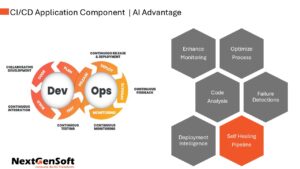The Influence of Microservices Architecture
Monolithic architectures limit growth, scalability, and agility. For instance, they experience 30-40% more downtime during upgrades, since a small change cycles the entire system. These architectures also impair development efficiency and result in 35% longer time-to-market, and slower feature rollouts.
NextGenSoft enables businesses to unleash the power of microservices by developing systems that are scalable and resilient. It can also mean the difference between planning a migration from your monolithic systems to a network of systems by leveraging our expertise and the latest tooling to make time to market for features reduced by 4 times.
From microservices interacting with one another through efficient REST, gRPC, or messaging queues. We design fault-tolerant architectures that contain failures in individual services, increasing uptime to 99.9%.

Benefits of Microservices & Serverless Architecture

Scalability
Microservices and serverless architecture empower automatic scaling based on a request, ensuring responsive applications during traffic spikes while dodging over-provisioning assets. reach out and Contact Us to learn more.
Faster Time-to-Market
Parallel development in microservices and simplified deployment in serverless platforms accelerate the discharge of new features, upgrading agility and efficiency.
Cost Efficiency
Serverless architecture services work on a pay-per-use model, lessening costs by eliminating costs tied to idle server capacity.
Resilience and Fault Isolation
In a microservices architecture, failures in one component do not influence the entire application. Similarly, serverless functions ensure isolated redeployment or investigation without downtime.
Enhanced Developer Productivity
Developers focus on coding without managing the foundation. Microservices consulting services enable groups to use the best-suited programming languages for each service.
Made strides Support
Measured design streamlines overhaul and bug fixes. Groups can freely upgrade particular administrations, guaranteeing consistent microservices design advancement without affecting others.
Challenges of Microservices & Serverless Architecture
Complexity in Management
Managing microservices and serverless architecture requires strong observing and investigating tools due to the intricacies of organization and scalability.
Security Risks
Each endpoint in microservices architecture increments the attack surface. Effective security measures like API gateways and IAM policies are significant in relieving risks.
Cold Start Latency
Serverless architecture services often face delays during initial invocation, especially in high-latency scenarios, affecting application execution.
Inter-Service Communication
Microservices architecture relies on API calls; arranging issues or misconfigurations can disturb operations, requiring meticulous planning and robust strategies.
Vendor Lock-In
Microservices & serverless architecture tie applications to specific cloud providers, making relocation costly and limiting flexibility, a key difference in microservices vs. serverless architecture talks about debate.
Best Practices for Microservices & Serverless Architecture
Design for Loose Coupling
Minimize dependencies between services in microservices and serverless architecture to ensure adaptability, independent updates, and decreased risk of cascading failures.
Implement Robust Monitoring
Leverage tools like AWS CloudWatch, Prometheus, or Datadog to monitor execution, detect bottlenecks, and troubleshoot effectively in microservices architecture environments.
Adopt API Gateways
Securely expose microservices with API gateways to handle confirmation, authorization, and ask throttling, basic for serverless architecture services.
Utilize CI/CD Pipelines
Automate testing and deployments to streamline the development lifecycle for both microservices architecture and serverless setups, ensuring unwavering quality and productivity.
Leverage Event-Driven Patterns
Utilize message queues like AWS SQS or Kafka to decouple services, optimize asynchronous processing, and upgrade resilience in microservices & serverless architecture.
Optimize for Cold Starts
Keep serverless functions lightweight by avoiding unnecessary conditions to reduce latency during cold starts, a basic factor in microservices vs. serverless architecture.
Secure Your Architecture
Apply the least benefit, encrypt delicate data, and review configurations regularly to ensure vigorous security for microservice architecture and serverless deployments.
Cost Analysis and Optimization
Review resource usage occasionally to optimize execution and anticipate cost overruns, particularly in serverless architecture service setups.
Cost Advantages with Microservices and Serverless Architecture
Pay-as-You-Go Model
As it were, pay for what you employ with serverless architecture, eliminating idle infrastructure costs and enabling a cost-effective approach.
Reduced Upkeep Costs
Cloud providers manage server upkeep, scaling, and fixing, lessening operational overhead and allowing focus on core exercises.
Optimized Resource Utilization
With automatic scaling, serverless platforms ensure efficient resource assignment, diminishing waste and improving cost management.
Example
Retail businesses running seasonal promotions can handle traffic surges consistently using serverless platforms like AWS Lambda. This highlights the difference between microservices and serverless architecture: adaptability with cost proficiency.
Why NextGenSoft?
End-to-End Expertise
Tackle our mastery in microservices architecture and serverless architecture services to build secure, versatile solutions. Our team plans vendor-agnostic strategies to maximize value while minimizing risk.
Delivery Excellence
Optimize your software delivery lifecycle with microservices vs. serverless architecture solutions. Achieve quicker, high-quality deployments, upgrading reliability and meeting client demands successfully.
Flexible Hiring Model
Scale your team easily with our versatile enlisting models for microservices architecture development. Access skilled experts tailored to your particular needs and project requirements.
Transparent Actions
Foster belief and alignment through open communication. Our microservices consulting services ensure clarity at every step, from planning to execution, promoting consistent collaboration, as showcased in our Case Studies.
FAQs
-
What are Serverless Microservices?
Serverless microservices combine microservices architecture with serverless computing, enabling developers to build versatile, event-driven applications without managing infrastructure, simplifying deployment, and decreasing operational costs. -
What is serverless computing?
Serverless computing may be a cloud model where providers manage infrastructure, permitting developers to focus on code. Perfect for serverless architecture services, it empowers automatic scaling and cost-efficient execution of microservices. -
What are serverless architectures?
Serverless architectures eliminate the requirement for server management by deploying applications as individual functions or services. They consistently integrate with microservices and serverless architecture to build agile, scalable solutions. -
What is microservices architecture?
Microservices architecture includes designing applications as loosely coupled, independent services, enhancing scalability and flexibility. It's broadly supported by microservices consulting services to enable productive, modular development. -
Which microservices architecture is best?
The best microservices architecture depends on your application's needs. Event-driven and API-first architectures regularly exceed expectations, supported by leading microservices architecture development companies offering tailored solutions. -
What is the difference between service-oriented architecture and microservices?
The difference between microservices and service-oriented architecture lies in scope and granularity. Microservices are measured and lightweight, while SOA focuses on enterprise-level integration and benefit reuse.
Contact us

Submit Your Inquiry

Detailed Proposal

Collaborate and Plan



